
Toyota Prius Plug-In Hybrid Review

Introduction
When you think of environmentally friendly vehicles, the Toyota Prius will still be the car on most people's lips, even though there are countless others nowadays.
With fully electric cars all the rage, it’s worth reminding ourselves that the Prius started life as a hybrid – and it’s still one today.
Though the original Prius was self-charging and remains so, there’s now a plug-in variant available, too, which is what we’re testing here.
Select's rating score* - 3.4 / 5
At a Glance
This is the fourth-generation Prius. Only the third and fourth have been available as plug-ins. But, of course, it’s based mainly on the self-charging variant that’s existed since the late 90s, so Toyota has had a lot of time to get it right.
It has gone through various overhauls and facelifts over the years, and the latest one was launched in 2018 – a facelifted version of the 2016 model.
But, in a world that’s becoming dominated by SUVs, the Prius now needs to work extra hard to retain its appeal. Therefore, updates and keeping up with the hi-tech gadgetry offered by rivals will be key.
Despite a modernised design, the Prius retains its classic boxy-wedge shape. But lines and creases in the bodywork give the aesthetics more definition.
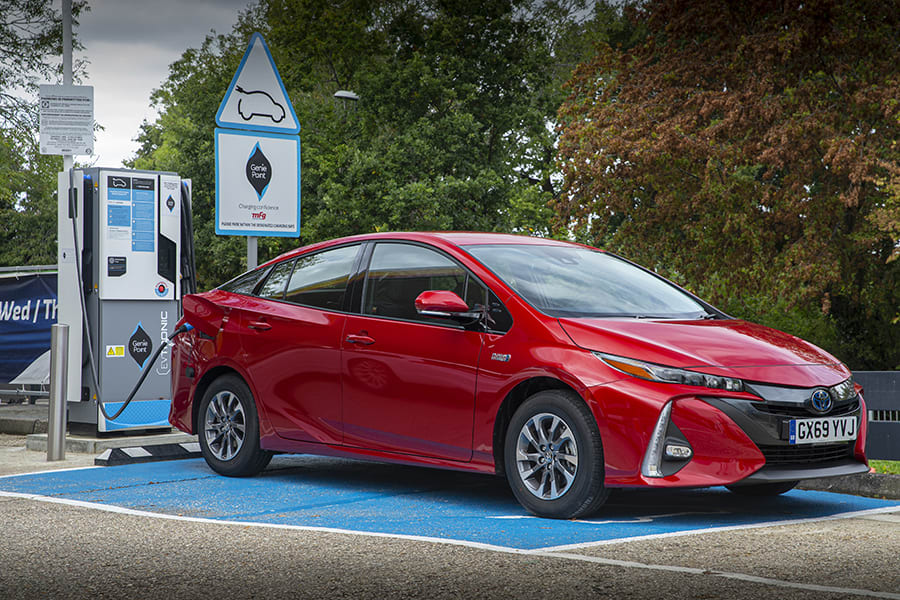
An indentation in the bonnet creates a ‘V’ shape, working its way down to the centre above the grille. Air intakes at the sides give it well-defined cheekbones, too. Meanwhile, the headlights have been given a narrower swooping design.
Side on, the boxy-wedge shape becomes more apparent, with the top of the boot being higher up than you’d find on most cars. Then there’s a diagonal line created by the windows that’s higher at the rear than at the front.
The back is straightforward, although the raised boot line with a panel of glass, which almost looks like a spoiler, remains. The rear lights surround the sides of the glass panel, with taillights underneath. These taper in to point at the centre of the boot.
The car’s looks still divide opinion, with some thinking it looks quirky and different, while others think it looks ungainly and ugly. The rear would arguably look untidy on any other vehicle. However, we’ve been used to this unique boot design on the Prius for such a long time that it’s able to pull it off.
Key Features
Two trims are available on the plug-in version – the entry-level Business Edition Plus and the top-of-the-range Excel.
The Business Edition Plus comes packed with kit, including 15-inch alloys, smart entry, and push-button start. You also get a wireless phone charger, a Toyota Touch2 infotainment system with Go Navigation, Apple CarPlay and Android Auto. On top of that, there are powered door mirrors, blind-spot monitoring, rear cross-traffic alert, a reversing camera, as well as automatic headlights and wipers. Dual-zone air conditioning, heated seats, power-adjustable lumbar support and a head-up display also feature.
The flagship Excel gets a handful of modest upgrades, including a leather armrest, a powered-reclining driver’s seat, front and rear parking sensors, and park assist. There’s also a JBL premium sound system with ten speakers, rather than the standard six.
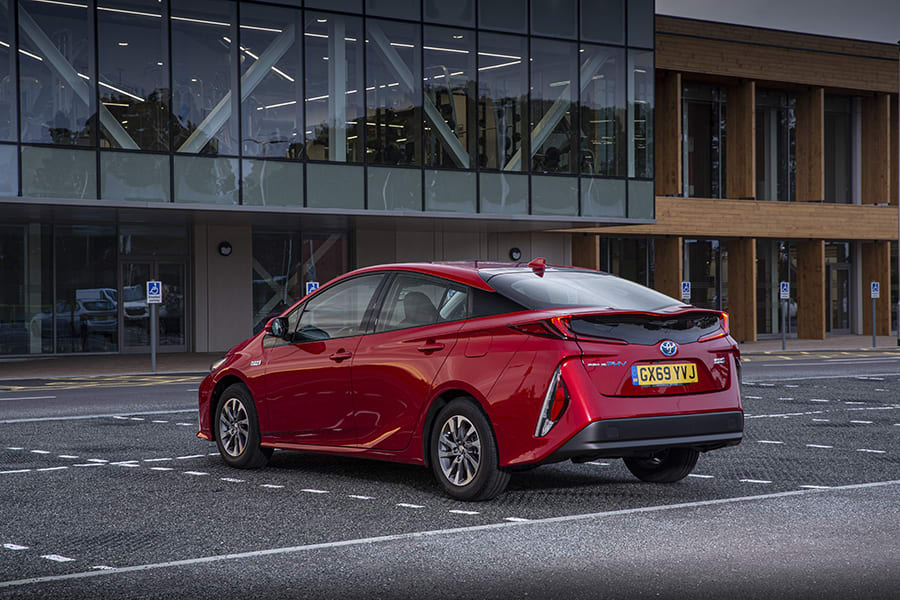
There's a choice of solid white for the body colours, or, if you want metallic paint, there’s black, dark grey, and aqua blue. Pearlescent paint is available in white or scarlet.
There is only one engine available, which is the front-wheel-drive 1.8-litre four-cylinder petrol automatic. This unit, when combined with two electric motors, produces 122PS.
There is little to choose between the two grades. But naming the entry-level trim ‘Business Edition’ suggests that Toyota is aiming this at company car buyers and taxi drivers.
Range & Batteries
The old plug-in hybrid could barely manage a trip to the local shopping centre before its batteries expired and called for the engine to kick in. Fortunately, its electric range has now been improved.
Indeed, the battery size has been doubled compared with its predecessor, from 4.4 to 8.8kWh, increasing the range to 34 miles.
When fully charged, it’s claimed you can get as high as 217mpg. Mind you, this depends on your driving style and the conditions being right.
You’ll be lucky to get more than 120mpg in the real world based on our tests. But this is still far greater than any current non-hybrid car can manage.
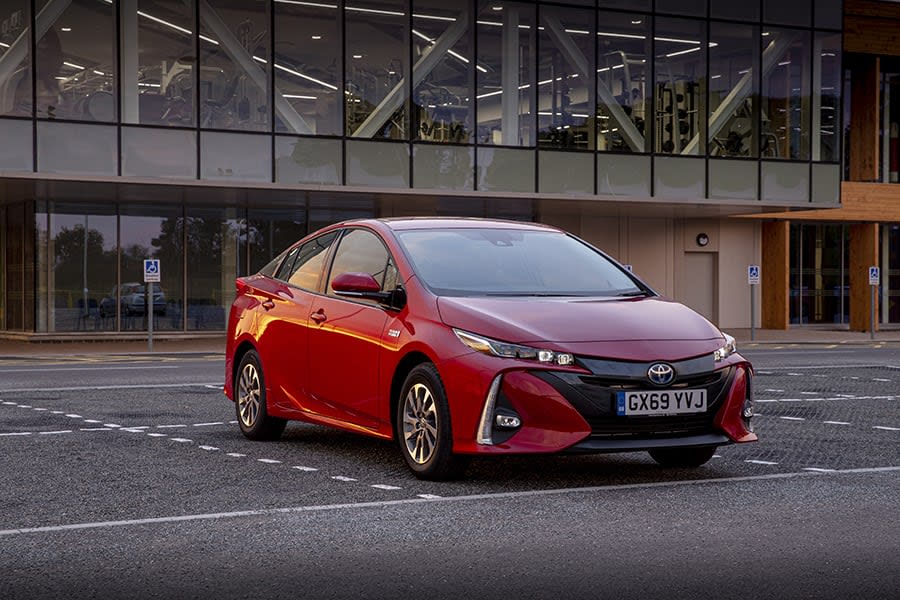
Performance & Drive
Driving the Prius is a pleasant experience, especially when using it as a town car.
The ride comfort is excellent, no doubt aided by the small 15-inch wheels. In addition, the suspension feels gentle and forgiving without ever seeming overly bouncy.
The lack of stiffness in the suspension makes for a lot of body roll, though. It is okay at low speeds, but it leans in the corners when you get going, despite the fact it's got decent grip. The steering is direct and responsive but, due to the tendency of the body to lean into bends, there’s no potential to enjoy the driving experience.
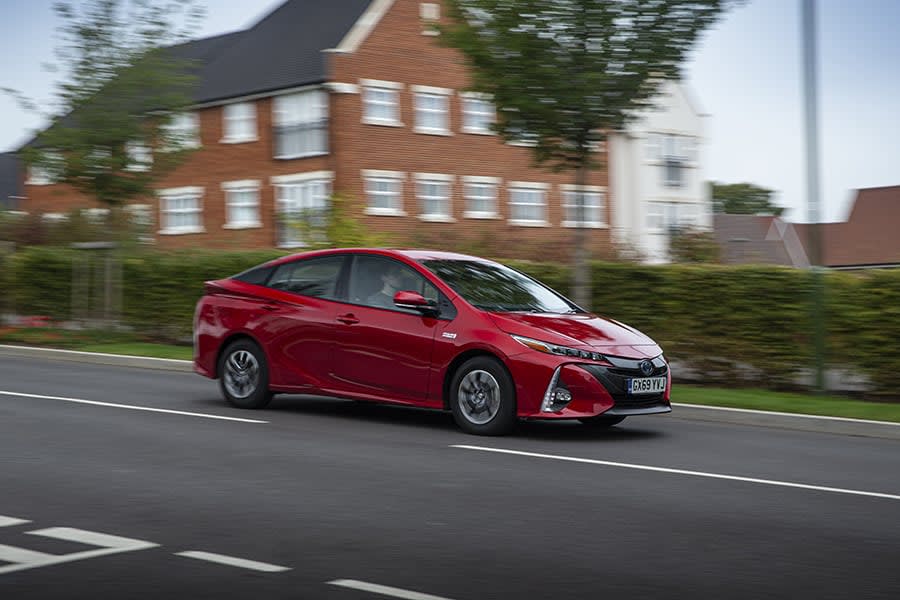
This is very much a car to cruise along in, rather than to play with. A lack of performance in terms of handling isn’t compensated for by the engine either.
Acceleration at low speed can feel quite zippy, and the 122PS powertrain delivers instantly once you put your foot down. This makes for a pleasant ride around urban areas. But sadly, this soon wears thin. When out of town, you realise zero to 62mph takes a painful 11.1-seconds, which is significantly slower than its rivals.
The Prius will run on pure electric energy, and it's barely noticeable when the engine does switch itself on. But, if you're demanding a burst of acceleration at the time, then it tends to scream with high revs.
It has a top speed of 100mph (although this is limited to 84mph in all-electric mode). But, in all honesty, you’ll feel you’re going to run out of road long before it gets there.
The brakes are pretty fierce, too, seemingly either being on or off due to the regenerative braking. This system uses the energy generated under deceleration to recharge the batteries. When it’s turned down, though, there is a more progressive feel to the brake pedal.
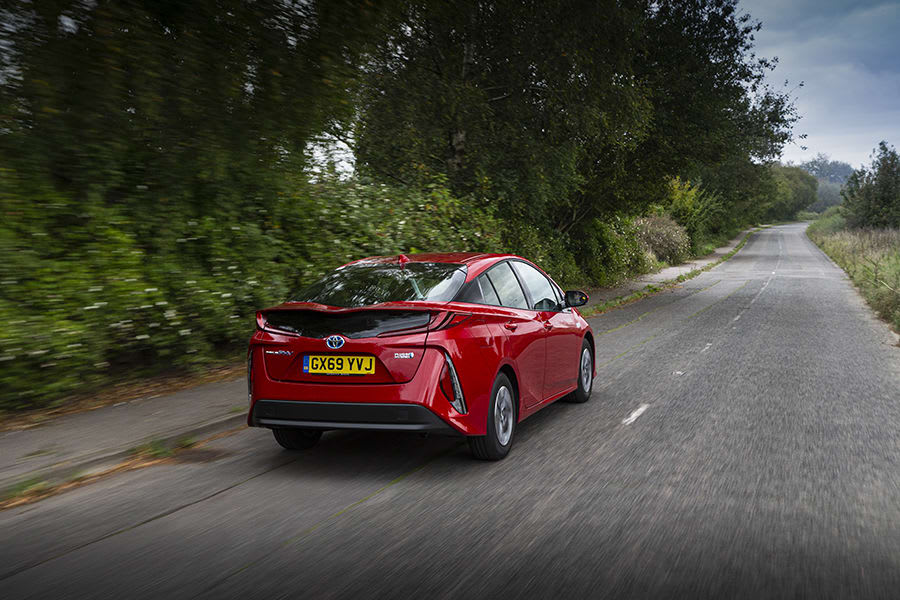
There is quite a lot of road noise, too, in part due to the tyres, which are designed to maximise the Toyota’s friendliness to the environment.
There are three driving modes to choose from. EV mode mainly uses the electric motors but will call upon the engine if required. HV (hybrid) mode uses the two seamlessly, while EV-city mode will only use the electric motors. It will switch to HV mode automatically when the charge in the batteries drops to a certain amount.
In addition, there are three performance modes called Eco, Normal and Power, although even the latter is still constrained by the car’s limited performance from the powertrain.
Charging
The battery can be charged in three hours using a domestic plug socket. However, this can be cut to two hours if you fit and use a wall box at home.
You can also use a preset timer to begin charging at a specific time, while this can also manage pre-heating of the cabin before you set off. This is great for those who park their cars outside their homes on a freezing winter’s night.
Rapid charging isn’t supported, but these sorts of chargers are more aimed at all-electric vehicles with bigger batteries to top up.
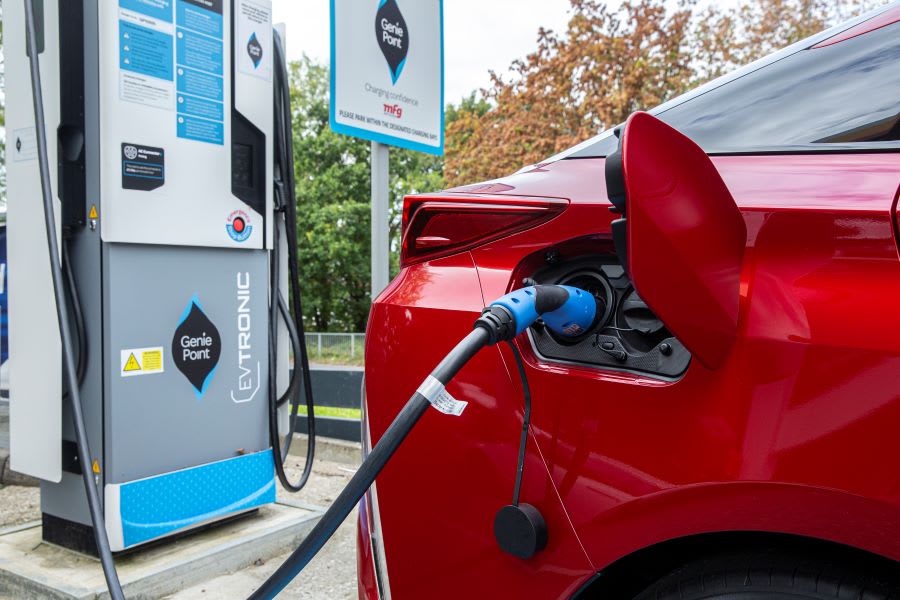
Running Costs & Emissions
The plug-in Prius produces 28g/km of CO2 when the petrol engine is in use. That said, emissions-free driving is possible by running the car purely from its electric motors.
The Benefit in Kind (BiK) tax is much lower than the self-charging Prius, which will appeal to company car owners.
One place where Toyota performs excellently is the warranty, which is five years as standard up to 100,000 miles. Most automakers offer three-year, 60,000-mile guarantees.
Interior & Technology
The interior is pleasant enough, although as new digital technology comes along, the overall dash layout does look a little dated. Everything is there, but the general cabin design is also beginning to look relatively tame compared with some rivals.
There are glossy surrounds to the infotainment system and, while there are some contrasting colours to break up the dark tone, it feels a little monotonal. However, you can choose a lighter coloured interior styling, which we think looks more appealing.
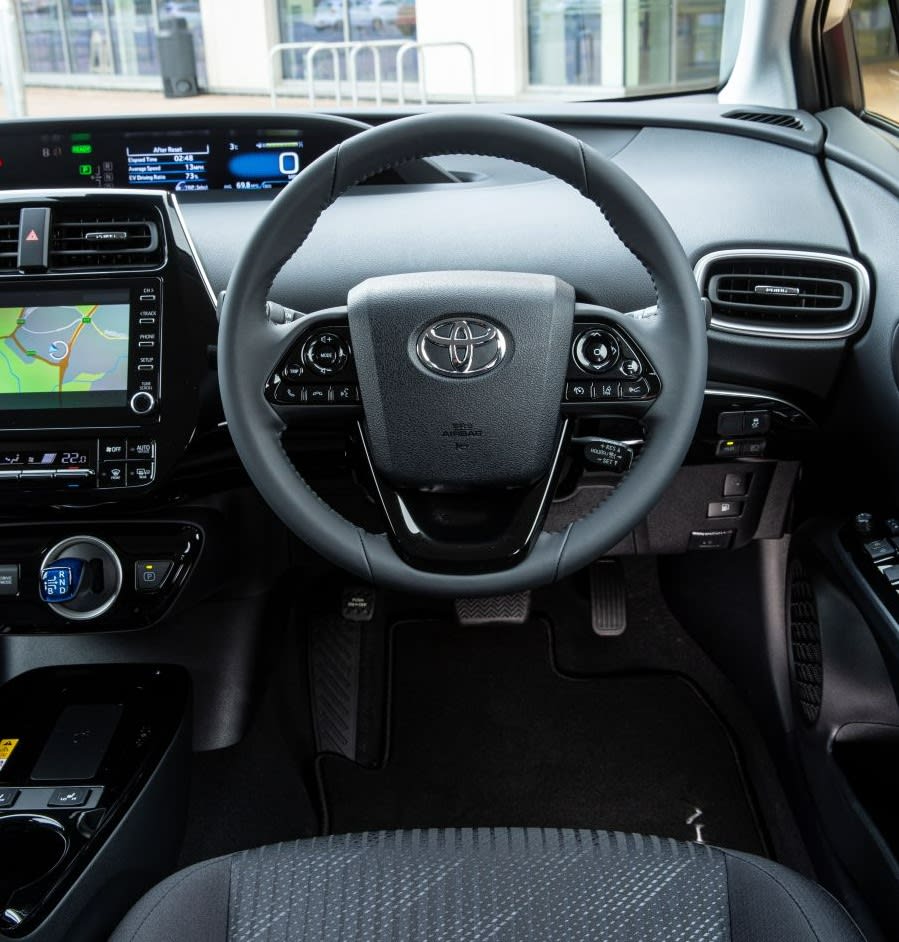
There are three screens; two of them, which are both 4.2-inches – are sat next to each other, effectively creating one wide but short screen, sprouting up from the centre of the dashboard. These contain the speedometer, fuel consumption readings, and additional information, such as warnings about who isn't wearing their seatbelt.
If the interior still disappoints, then the third screen – the eight-inch infotainment system – will disappoint even more so. Although it’s functional and relatively easy to use, it looks tired, and it’s very laggy, especially when on the SatNav screen.
There are soft-touch surfaces on offer, but cheap hardened plastics are never far away. On the plus side, the head-up display is an impressive touch that adds class to the cabin. Elsewhere, the seats are comfortable, and there is plenty of space.
Overall, it feels like Toyota has done just about enough without going the extra mile. It’s sufficient, but nothing special.
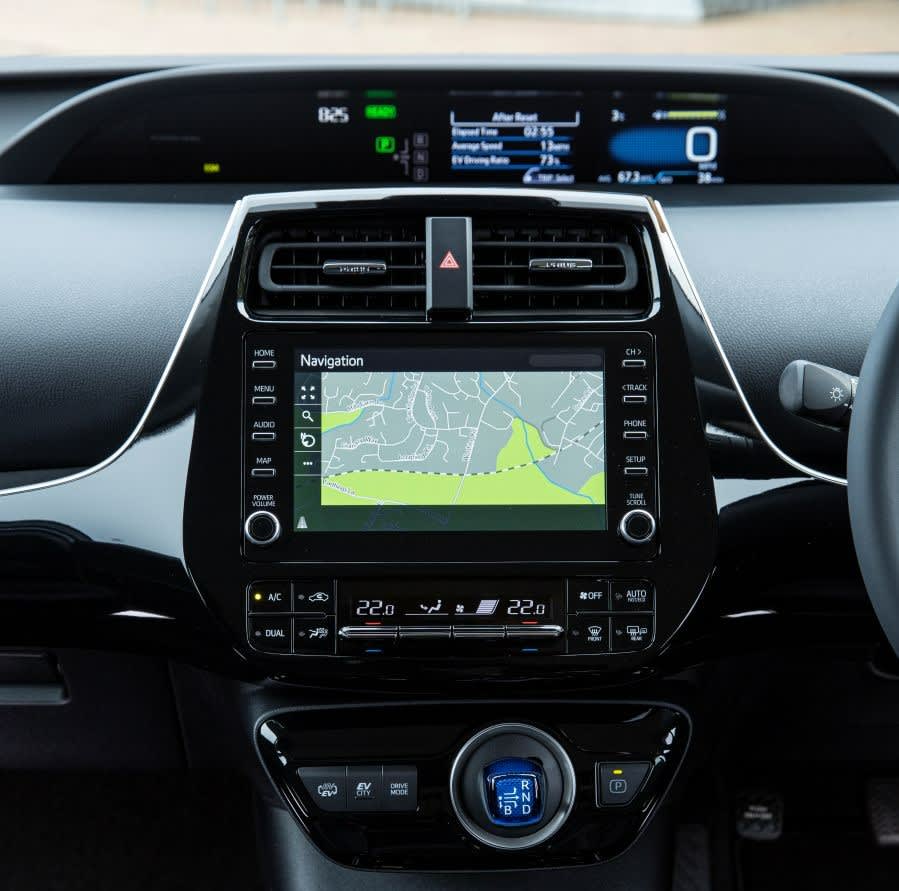
Practicality & Boot Space
In the back, the rear seats offer a reasonable amount of space. Legroom is plentiful, but taller passengers are likely to struggle for headroom due to the sloping roofline.
There’s a single 12-volt cigarette-style socket in the back, rather than USB ports, which is frustrating, but nothing a simple adapter can’t solve.
An armrest folds out from the middle seat revealing a couple of cupholders, too.
Being a hatchback with a sloping roof, the boot opens widely. Instead of a conventional parcel shelf, the one provided is made of flexible fabric and can be retracted entirely into the car out of sight. This helps you fit in bulkier items without needing to leave the parcel shelf at home before you set off. That said, it can still be taken out if required and stored beneath the boot's floor in a dedicated space.
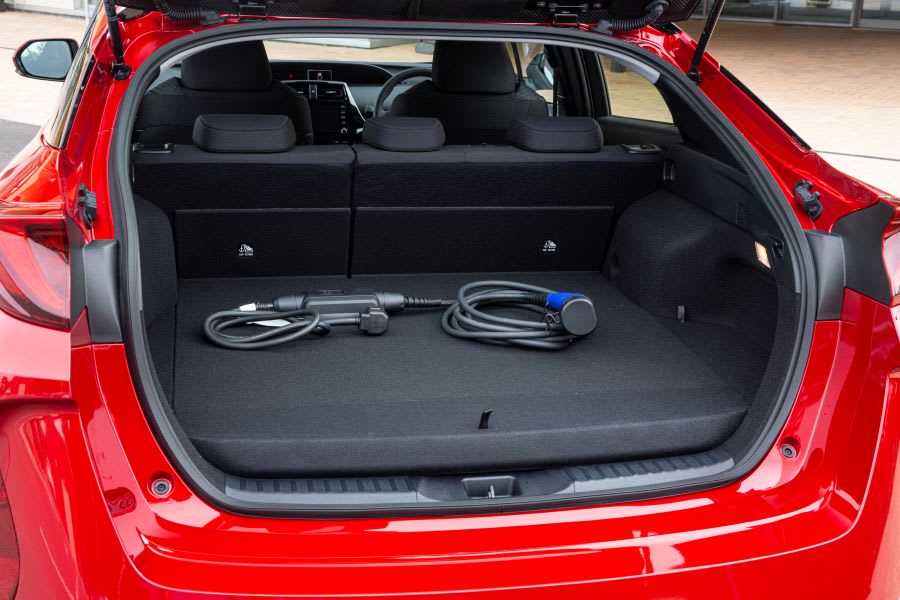
There is 359-litres of space, although this is significantly less than the 502-litres you get in the self-charging version due to the additional batteries beneath the boot floor.
If you need more room, the rear seats fold down in a 60/40 configuration, providing 1,204-litres.
Safety
Euro NCAP tested the Prius back in 2016, awarding it a five-star rating.
Although we're driving a facelifted version, it's still fundamentally the same car, so the rating is still just as relevant.
It earned a 92% score for adult occupants, 82% for child occupants and an impressive 85% for safety assists. This latter score is due to Toyota including just about all its safety systems as standard.
Vehicle stability control, traction control, hill-start assist control, tyre pressure warnings and rear cross-traffic alert are all included. However, rear parking sensors are an optional extra on the Business Edition Plus grade.
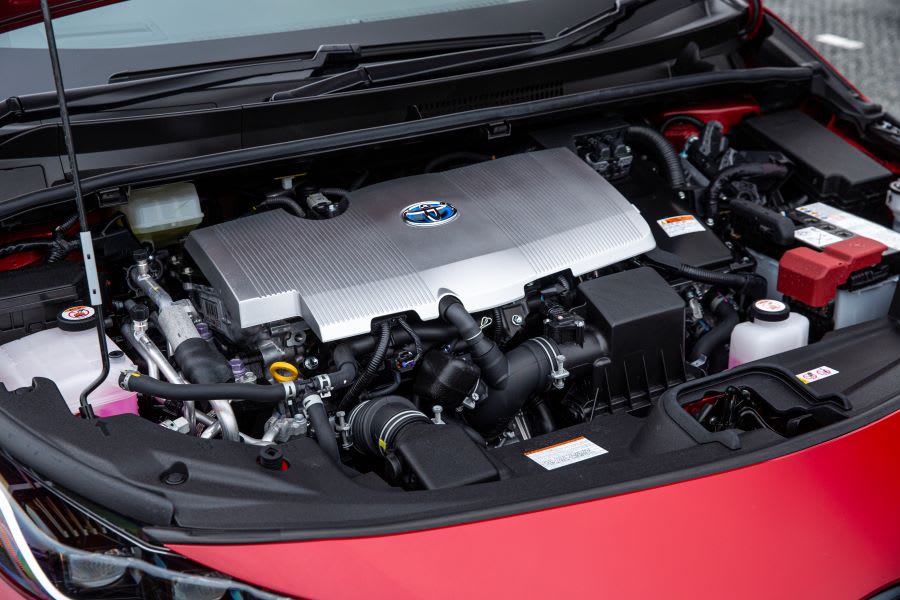
In addition, lane departure alert with steering control, lane trace assist, and road sign assist are thrown in. Adaptive cruise control, a system that keeps you at a safe distance from the vehicle in front, is included as well.
The pre-collision system, which is also built-in, uses a camera and laser to detect other vehicles and cyclists and pedestrians. If it thinks a collision is imminent, it sounds and displays a warning telling you to brake. If the driver doesn't react, the brakes are applied automatically.
Options
The options list is boring, but that’s good news because Toyota has packed lots of kit into the Prius.
As a result, the Essential Protection Pack – which includes a boot lining, a rear bumper protection plate and both front and rear mud flaps – is about as exciting as it gets.
Or, if you mean business, the Essential Protection Pack Plus throws in the same but adds aluminium scuff plates on the door sills, too.
We’re taking the mickey a bit here because there’s not much to write home about. But, on a serious note, Toyota should be commended for leaving the options list reasonably bare while packing lots of stuff into the standard car that many rivals would charge extra for.
Most of the items included in the protection packs can be acquired individually, too.
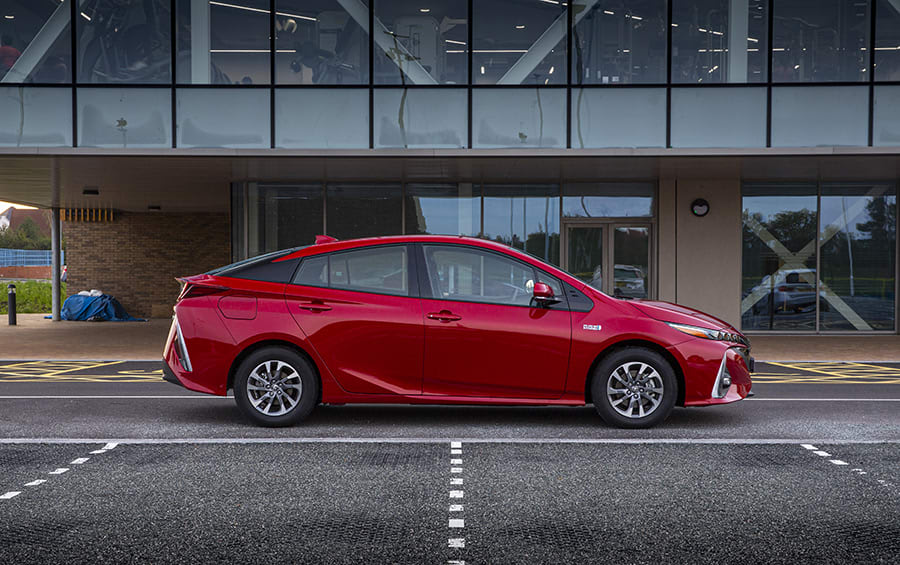
Rival Cars
If you're looking at plug-in hybrids, the Skoda Superb iV and the Volkswagen Passat GTE are good alternatives. Both cars have better quality interiors and deliver far more drivability, despite being in a similar price bracket to the Prius.
If you don’t mind something a little larger, a Volvo XC40 plug-in hybrid SUV is more expensive but may be worth the extra if you want something more luxurious.
There is also the Peugeot 3008 and the Vauxhall Grandland Hybrid to consider, although these are SUVs, too.
Of course, just because there’s a Prius plug-in hybrid variant, it doesn’t mean you need to choose that one. There’s still a self-charging model that is cheaper and offers more boot space. Mind you; the fuel economy is nowhere near the efficiency provided by the plug-in version.
You could also go all-electric for not much more money. The Hyundai Ioniq 5 is an excellent small SUV that may be worth checking out, along with Kia’s e-Niro.
The Hyundai Ioniq (not to be confused with the Ioniq 5, which is a different car) is also impressive. The vehicle is similarly proportioned to the Prius and is available in self-charging and plug-in hybrid variants, although an all-electric version is being discontinued.
Verdict & Next Steps
The Toyota Prius is often thought of as the king of the hybrids. But, while it does have its good points, its notoriety is more to do with it being the first mass-produced hybrid, rather than for its quality as a superior car.
Every other manufacturer has joined the party since - many of whom have long surpassed the Prius for performance and luxury.
The safety features offered are impressive, and a generous amount of kit comes as standard. But the car’s downsides, including its underpowered engine and substandard handling, can make journeys over longer distances frustrating.
A somewhat mediocre interior design does little to help. And this, added to a dated infotainment system, means it doesn’t cut the mustard anymore when compared with plenty of its rivals.
On the plus side, it is comfortable, practical, and spacious – and the five-year warranty is commendable. If you only intend to drive the Toyota around town, then the larger downsides are more likely to be avoidable.
It is a shame, too, as the Prius is a likeable car, while Toyota should be lauded for offering so much as standard. Saying you’ve got a Prius also remains a powerful statement of your environmental credentials.
But the sad reality is, it’s long since lost its magic, and there are better alternatives that will be more suited to most motorists’ needs.
Where to next?
View latest Toyota Prius PHEV leasing deals - from just £309.43 per month inc VAT**
Looking for a great leasing deal? Check out our incredible range of car lease deals
New plug-in hybrid car? Read our latest Car Reviews and find the right model for you
Want to know more about hybrid-electric leasing? Take a look at our comprehensive Leasing Guides
Interested in everything motoring? Why not catch up on all the latest Car Leasing News.
**Score based on Select’s unique meta score analysis, taking into account the UK’s top five leading independent car website reviews of the Toyota Plug-in Hybrid Prius
**Correct as of 15/10/2021. Based on 9 months initial payment, 5,000 miles over a 48 month lease. Initial payment equivalent to 9 monthly payments or £2,784.87 Ts and Cs apply. Credit is subject to status.





















